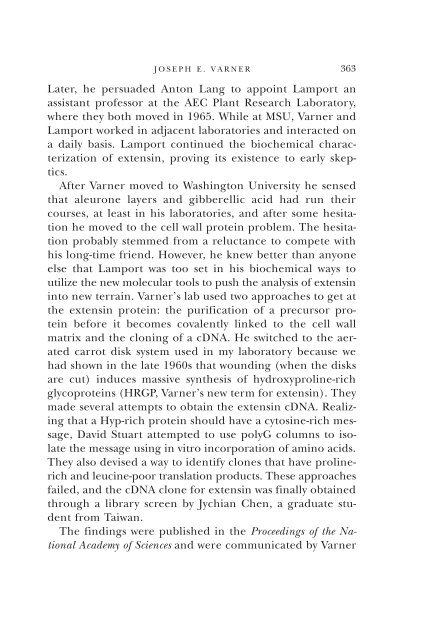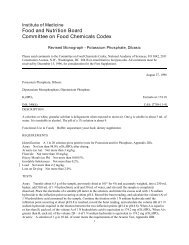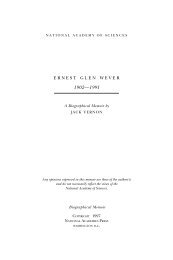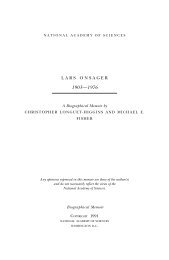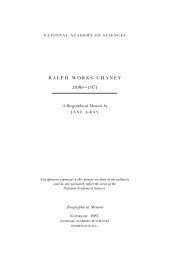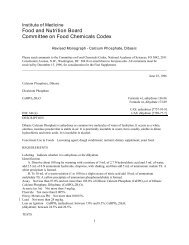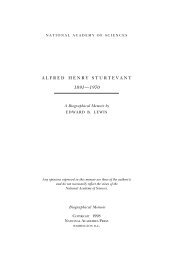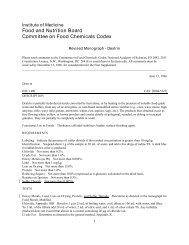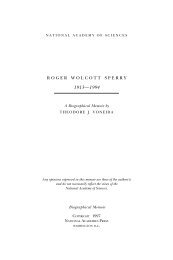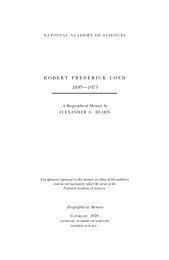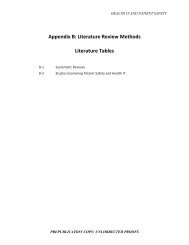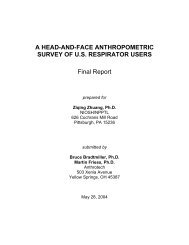JOSEPH E. VARNER - National Academy of Sciences
JOSEPH E. VARNER - National Academy of Sciences
JOSEPH E. VARNER - National Academy of Sciences
You also want an ePaper? Increase the reach of your titles
YUMPU automatically turns print PDFs into web optimized ePapers that Google loves.
<strong>JOSEPH</strong> E. <strong>VARNER</strong><br />
363<br />
Later, he persuaded Anton Lang to appoint Lamport an<br />
assistant pr<strong>of</strong>essor at the AEC Plant Research Laboratory,<br />
where they both moved in 1965. While at MSU, Varner and<br />
Lamport worked in adjacent laboratories and interacted on<br />
a daily basis. Lamport continued the biochemical characterization<br />
<strong>of</strong> extensin, proving its existence to early skeptics.<br />
After Varner moved to Washington University he sensed<br />
that aleurone layers and gibberellic acid had run their<br />
courses, at least in his laboratories, and after some hesitation<br />
he moved to the cell wall protein problem. The hesitation<br />
probably stemmed from a reluctance to compete with<br />
his long-time friend. However, he knew better than anyone<br />
else that Lamport was too set in his biochemical ways to<br />
utilize the new molecular tools to push the analysis <strong>of</strong> extensin<br />
into new terrain. Varner’s lab used two approaches to get at<br />
the extensin protein: the purification <strong>of</strong> a precursor protein<br />
before it becomes covalently linked to the cell wall<br />
matrix and the cloning <strong>of</strong> a cDNA. He switched to the aerated<br />
carrot disk system used in my laboratory because we<br />
had shown in the late 1960s that wounding (when the disks<br />
are cut) induces massive synthesis <strong>of</strong> hydroxyproline-rich<br />
glycoproteins (HRGP, Varner’s new term for extensin). They<br />
made several attempts to obtain the extensin cDNA. Realizing<br />
that a Hyp-rich protein should have a cytosine-rich message,<br />
David Stuart attempted to use polyG columns to isolate<br />
the message using in vitro incorporation <strong>of</strong> amino acids.<br />
They also devised a way to identify clones that have prolinerich<br />
and leucine-poor translation products. These approaches<br />
failed, and the cDNA clone for extensin was finally obtained<br />
through a library screen by Jychian Chen, a graduate student<br />
from Taiwan.<br />
The findings were published in the Proceedings <strong>of</strong> the <strong>National</strong><br />
<strong>Academy</strong> <strong>of</strong> <strong>Sciences</strong> and were communicated by Varner


